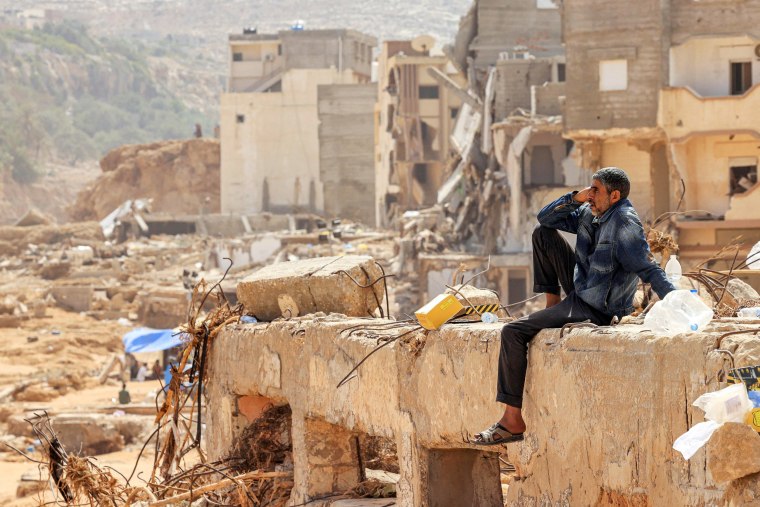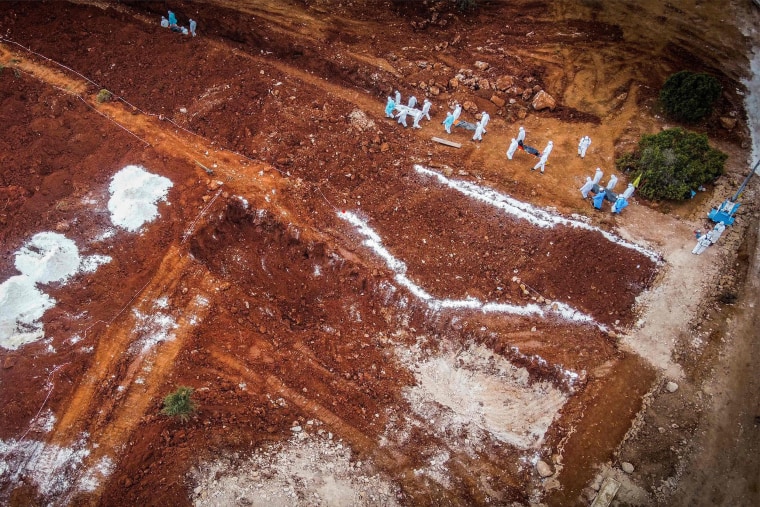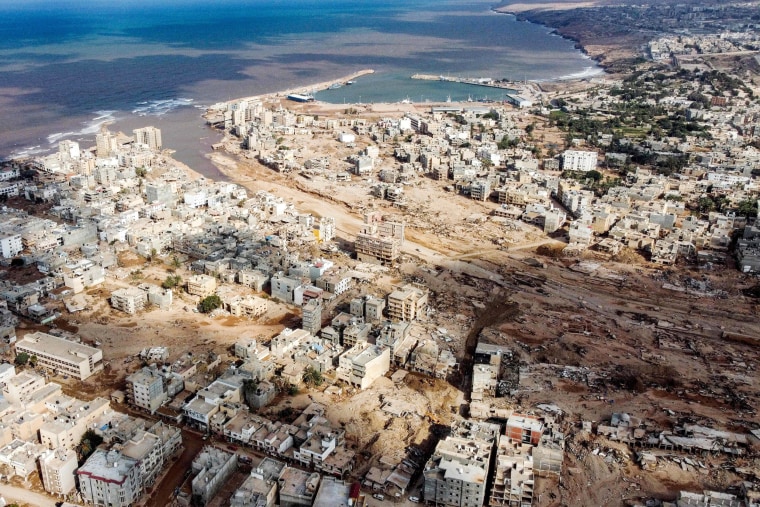A race to the roof was all that saved them from the deluge.
It was like being “in the middle of the sea with massive waves crashing around,” said high school teacher Ahmad al-Sharif, who scrambled to the top of his building with some neighbors as a wall of water swallowed up cars, homes and bodies.
In the darkness and faced with a wave of water so large it felt like a “tsunami appearing in front of you,” he recalled, neighbors were screaming as the deluge destroyed the city. Some were shouting “Save us! “Help us!” while others were saying the Shahada, the Islamic affirmation of faith, as the waves crashed over them and pulled them under.
Al-Sharif, 34, spoke by voice message from a shelter in Derna, the city in eastern Libya that was devastated by last week’s floods.
“Most of my friends from the neighborhood” have died, he said. “People have been found in their homes. … People have been found in the sea.”

Thousands of people have been killed, with thousands more missing in the floods, which survivors and experts said was not merely a natural disaster.
Years of civil war, corruption and institutional neglect left residents of the North African state at the mercy of Mediterranean storm Daniel’s extreme weather, as did the authorities who “frankly had nothing but contempt for their people,” said Tarek Megerisi, a Libya expert and senior fellow at the European Council on Foreign Relations, a think tank.
Fury that simmered for a week has erupted into protests against local officials, with the home of Derna’s ousted mayor having been torched.
Here’s how the heavy rain turned so deadly in Libya.
From livestreaming to fleeing
The rain was getting heavier and heavier around midnight, but residents in the Wadi Derna Valley felt confident that the dams would hold — as they had before.
The two structures, Abu Mansour and Derna, just uphill from the Mediterranean coastal city, were meant to protect its almost 90,000 residents.
The people were used to occasional flooding, and on Sept. 10, even rain heavy enough to fill the first dam did not sound the alarm.
“We’re used to this. … We’ve seen the same scene in 2011 without a catastrophe happening,” said al-Sharif, who was streaming it all live on Facebook as the canal started overflowing.
Residents recorded videos of the water level rising, then returned home to dry off and sleep as the night got darker and wetter.
But it was soon clear that this was not just another downpour.
“We started to hear screaming in the streets. ‘Torrent! Torrent is coming!’ So everyone went out onto their balconies to look, and we saw the torrent rushing into the streets with a very big force,” al-Sharif said.
It was about 2:30 a.m., he recalled, and cars were lying overturned on streets covered in mud. Thinking the worst was over, people headed out to clean up the roads.
Then “the tragedy happened.”
Around 3 a.m., it was clear both dams had given way, as a second wave almost as high as the buildings in the neighborhood charged toward the residents, who ran to take whatever high ground they could and grab neighboring families to escape with them.
Some, like al-Sharif, were lucky to find their stairs taking them just out of reach of the water rushing up floor after floor behind them. After he finally reached the roof, he was shocked to see what was happening outside.
“The entire place was all submerged in water. … You don’t see anything but water” he said.
“God had mercy on us,” al-Sharif said. “Our building survived, but the other buildings were completely wiped out, taken away with the torrent like they were biscuits.”
Residents waited until 7 a.m. for the water to recede. Al-Sharif said he walked for two hours to find safety and aid, stalked all the way by the overwhelming tragedy. “The smell of death travels down all the roads,” he said.
While the water brought death to Derna in a devastating and sudden rush for many residents, the floods were preceded by a litany of unheeded warnings.
Missed warnings
In a research paper published last year, hydrologist Abdelwanees Ashoor of Libya’s Omar Al-Mukhtar University warned the Derna “area has a high potential for flood risk,” citing five floods there since 1942 and calling for immediate maintenance steps for the dams.
“In the event of a big flood, the consequences will be disastrous for the residents of the valley and the city,” he wrote in the Sebha University Journal of Pure and Applied Sciences.
Some Libyan officials have also not refrained from criticizing authorities.
The dams suffered major damage in a strong storm that hit the region in 1986, and more than a decade later a study commissioned by the government revealed cracks and fissures in their structures, Libya’s general prosecutor, al-Sediq al-Sour, said last week.
But years went by as cautionary reports piled up and restoration efforts either failed to get off the ground or were abandoned in the chaos of civil war.
At a news conference in the stricken city, al-Sour said prosecutors would investigate the collapse of the two dams, as well as the allocation of maintenance funds.
“I reassure citizens that whoever made mistakes or negligence, prosecutors will certainly take firm measures, file a criminal case against him and send him to trial,” he said.
Survivors are in no doubt about what or whom to blame.
“The main cause of the disaster was the dam located south of Derna, which had not undergone recent maintenance,” said Salem Mansour, 27, who lost his sister in the disaster. Speaking from the hospital in the nearby city of Tobruk, he was convinced that more could — and should — have been done to prevent this.
“The responsibility lies with the successive corrupt governments in Libya, which neglected the safety of citizens,” he said.


The country plunged into a spiral of conflict and civil war after opposition fighters killed longtime dictator Moammar Gadhafi in a NATO-backed Arab Spring uprising in 2011. Divided between rival administrations and riven by corruption, the country’s infrastructure and public services have been neglected.
Derna is under the authority of the country’s eastern administration, controlled by the self-styled Libyan National Army of Gen. Khalifa Hifter, while the country’s west is ruled by the Government of National Unity, based in the capital, Tripoli.
“Most of the civilian infrastructure has been in a state of dilapidation since their construction. There wasn’t regular careful and systematic management of the Libyan infrastructure. It’s really been rotting,” said Megerisi, the Libya expert.
“The country is becoming a failed state. Nobody has looked after it,” he said.
Hifter’s son Saddam Hifter, considered by many as the heir apparent, refused to blame the administration, telling Sky News “all is OK” when he was asked about the flood warnings.
Climate extremes and chaotic rule
Anger among residents fueled protests against local officials this week, with the home of Derna’s ousted mayor, Abdel-Moneim al-Ghaithi, being set on fire after hundreds of people gathered in the city, chanting slogans and demanding accountability.
Authorities have been quick to respond, imposing a communications blackout and even ordering journalists to leave the area, calling it a necessary move for rescue operations.
One source of that anger is a sense that warnings were missed not just for years before the flood, but also in the days before the storm.
A day before Daniel hit Libya, al-Ghaithi said at a news conference that some areas surrounding the dam should be evacuated. But an emergency committee formed by the eastern government’s interior ministry instead imposed a curfew that was supposed to have lasted through the morning of Sept. 11.
The confusion was a sign of the kind of chaotic governance and emergency response failure that global officials said was a crucial factor.
Petteri Taalas, the head of the World Meteorological Organization, said at a news conference last week that “most of the human casualties” could have been avoided had the local and national authorities issued the correct warnings and carried out evacuations.
“The fragmentation of the country’s disaster management and disaster response mechanisms, as well as deteriorating infrastructure, exacerbated the enormity of the challenges,” he said.
In countries like Libya with no singular nationwide administration, where corruption is rife and public infrastructure is often an afterthought, efforts from prediction to prevention are made less reliable, analysts said.
And all of it only highlights a glaring issue facing the world: The effects of climate change are making acute weather phenomena like Daniel more frequent, placing additional stress on flawed structures — and states.
“Climate change is increasing weather extremes, stresses infrastructure and makes management and preparation all the more important,” said Kimberly Nicholas, a sustainability science lecturer at Lund University in Sweden.
Timely prediction of the storm and a response like the swift opening of the dam gates might have helped prevent such a disaster, experts said. But failing to identify the threat to Derna despite all the warnings was the ultimate failing, said Nadhir al-Ansari, a professor of civil, environmental and natural resources engineering at Luleå University of Technology in Sweden who has been studying water resources in the Middle East for the past 40 years.
“The government should have examined the areas that could be flooded in case of failure. They shouldn’t have allowed the building of houses in such areas. Nobody thought of this,” he said.
At least one resident did, in a poem that warned of the dangers of the floods.
Mustafa al-Trabelsi had attended a meeting Sept. 6 in Derna to discuss the threat of flooding there. Days later, he wrote the poem, which has been shared widely in the wake of the disaster.
It reads, in part:
“The rain exposes the drenched streets,
the cheating contractor,
and the failed state.”
Al-Trabelsi has not posted anything since the floods, leading to fears for his safety.


